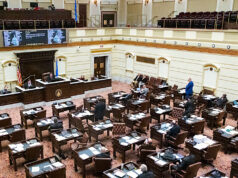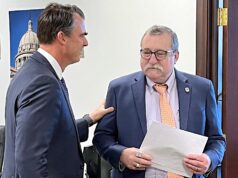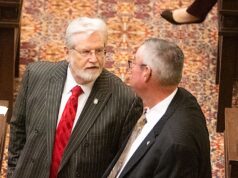
In 1974, a group of University of Oklahoma journalism students produced a quirky documentary about the Oklahoma Legislature called But What Do They Do In There? The Oklahoma Legislative Process (embedded above). The film is a strange mash-up of 1970s counterculture vibes and straight-laced lawmakers, with J.J. Cale’s Okie providing the soundtrack, hilarious comments from ordinary citizens about their elected officials and a guest appearance by a young future-Gov. Frank Keating.
The host is a contemplative young reporter-professor type who looks like he probably smoked a few jazz cigarettes with his students after class. As viewing progresses, a complete lack of diversity in both the Legislature and in the subjects who were interviewed becomes apparent. Yes, you will see some diversity, especially when the film highlights newly elected members of the Legislature, but even with the good intentions of the journalism class, the conventions of the day make an appearance.
‘An interesting window into a time long past’
The film has an irreverent edge to it that lets the viewer know that the filmmakers get it: The legislative process is boring, and these old farts at the State Capitol are weird. Anyone who has been around the House or Senate knows how complicated the sausage making can be. The film does a great job of reminding us about the ins and outs of how elected leaders make laws in a way that’s easy to follow. It’s also an interesting window into a time that is long past, when all political power in the state emanated from U.S. House Speaker Carl Albert and small eastern Oklahoma cities like Muskogee and McAlester were busy centers of political intrigue.
The backdrop of the film is the bill it follows, a measure that would allow the State of Oklahoma to continue doling out capital punishment after a Supreme Court ruling curbed the ability of states to administer such penalties. (Side note for #okleg junkies: At the 16:25 mark, then-Speaker of the House William P. Willis explains the Committee of the Whole process, which is no longer used.)
But to be honest, it’s not so much the actual intent of the film that I enjoy. I like the ridiculous fashions these legislators were displaying, and I like seeing both good and bad themes from a different era on display. Members smoke cigars on the House floor, chew tobacco and show no mercy in their disdain for freshmen lawmakers. Their gruff voices with thick Okie accents are a reminder that the Legislature used to be an even rougher and rowdier place than it is these days, with only one or two women seen on screen. The small amount of minority legislators is also apparent, but unfortunately that’s not much different from the present day.
Through the use of irreverent humor, current music and good journalistic skills, this OU class produced an admirable piece that is now a time capsule for any student of Oklahoma history. Overall, I love the pluckiness of the film, but viewing it reminds me of a line from the venerable Tulsa hip-hop artist Steph Simon in his song Visions, where he states, “I can see how far we’ve come, and I can see how far we got to go.”




















